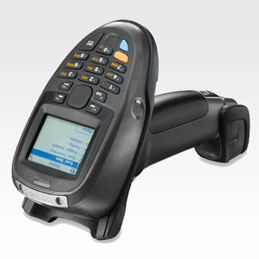|
Motorola MT2000
A simple scanner, but also a computer
(by Conrad H. Blickenstorfer)
On September 3, 2009, Motorola introduced the MT2000 series of mobile terminals that are meant to combine the simplicity of a scanner with the brainpower of a mobile computer - all packaged in a handy, ergonomic package with the popular gun-style form factor. The idea here is to add smarts, and thus flexibility and power, to a conventional laser scanner.
 MT2000 Series scanners can be used either tethered to a point-of-sale or other computer, or wirelessly for real-time application connectivity retail, warehouses, shopfloors, etc. The systems also include Bluetooth Class I for cordless connectivity with a range of up to 300 feet. MT2000 Series scanners can be used either tethered to a point-of-sale or other computer, or wirelessly for real-time application connectivity retail, warehouses, shopfloors, etc. The systems also include Bluetooth Class I for cordless connectivity with a range of up to 300 feet.
The computer side of the MT2000 is standard-issue Windows CE/Pocket PC technology. The devices are powered by the 312MHz version of the Marvell PXA270 application processor, they have 64MB of RAM and an equal amount of ROM, and they run Windows CE 5.0. The color display uses the ubiquitous 320 x 240 pixel QVGA format, and there is bth USB host and serial RS-232 connectivity.
Physically, the MT2000 Series features the rounded, ergonomic design favored by Symbol in many of their scanning products. The footprint of the scanning puck is about 3 x 5 inches, and the whole scanner, including the large and comfortable pistol grip, weighs 13.5 ounces, well under a pound.
Scanners can expect a good bit of abuse during operation in the field, and so Motorola designed the MK2000 Series with ruggedness built in. That includes the ability to survive 6-foot drops onto concrete, IP54 sealing, tumbling onto hard surfaces, a very wide -4 to 122 degree Fahrenheit operating temperature range, as well as conformance to ESD, EMI/RFI, laser safety and other standards.
The MT2000 Series can be ordered with four different scanner configurations, those being:
- 1D laser (1-50 inch range, ability to read poor quality/damaged codes)
- 1D/2D imager (capture 1D and 2D bar codes as well as signatures, images and video)
- 1D/2D HD imager
- DPM imager
Symbology decoding capabilities are as follows:
- UPC/EAN (UPCA/UPCE/UPCE1/EAN-8/EAN-13/JAN-8/JAN-13 plus supplements
- ISBN (Bookland)
- Code 39 (Standard, Full ASCII, UCC/EAN-128, ISBT-128 Concatenated)
- Code 93
- Codabar/NW7
- MSI Plessey
- I 2 of 5 (Interleaved 2 of 5 / ITF
- Discrete 2 of 5
- IATA
- Chinese 2 of 5)
- GS1 DataBar (Omnidirectional, Truncated, Stacked, Stacked Omnidirectional, Limited, Expanded, Expanded Stacked, Inverse)
- Base 32 (Italian Pharmacode)
- TLC-39
- Aztec (Standard, Inverse)
- Maxicode
- DataMatrix/ECC 200 (Standard, Inverse)
- QR code (Standard, Inverse, Micro)
- PDF417 (Standard, Macro)
- Composite Codes (CC-A,CC-B,CC-C)
- U.S. Postnet and Planet
- U.K. Post
- Japan Post
- Australian Post
- Netherlands KIX Code
- Royal Mail 4 State Customer
- upu fics 4 State Postal
- USPS 4CB
Manual data entry is via a shiftable 21-key alphanumeric keypad that can be used for applications that require primarily numeric or text-based entry or both. You can also program soft keys to perform actions with the single press of a button.
Devices like the MT2000 are used in conjunction with cradles. Here, Motorola offers a) a single slot charge only cradle, b) a single slot multi-interface with Bluetooth cradle, c) a single slot charge only fork lift cradle, d) a 4-slot charge only cradle, and e) a 4-slot Ethernet cradle.
|



